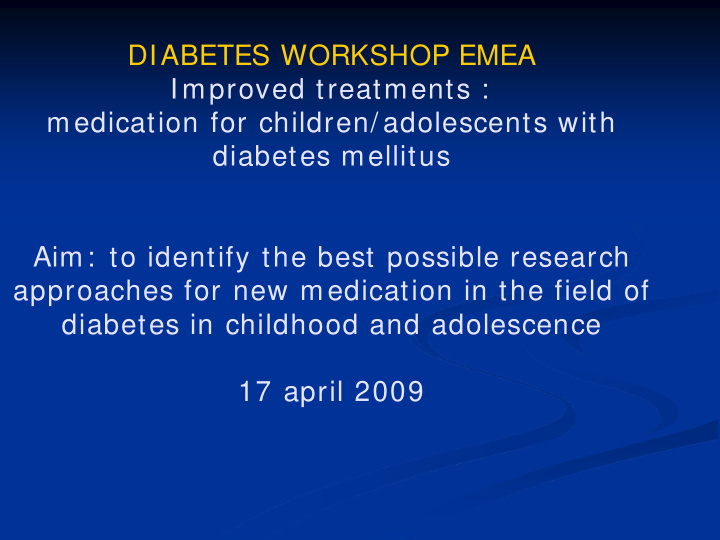



DIABETES WORKSHOP EMEA Improved treatments : medication for children/ adolescents with diabetes mellitus Aim: to identify the best possible research approaches for new medication in the field of diabetes in childhood and adolescence 17 april 2009
Type 1 and 2 diabetes in children and adolescents Actual known numbers in the EU Short introduction on actual situation : new products � non insulin and insulin Results of the premail questions
EUCID EU study 2006 Crude annual incidence rate of diabetes /100.000 population 0-14 years (core indicator) 80 Crude incidence rates (/100 000) 60 40 20 0 Luxembourg Austria Cyprus Denmark England Germany Poland Scotland Sweden Finland France Spain 2004 2005# 2005 2005 2005# 2005 2005 2005# 2005 2005* 2005 2004 Clinical database Administrative database type 1 type 2 total
PRE meeting questions Type 2 dm 1) For non inferiority studies in paediatric diabetes vs insulin/ metformin : what delta HbA1c should be considered significant Delta HbA1c : 0.3-0.5 % Not different from adults (CHMP 0.3-0.4% ) 2) For new insulin analogues : are data in t2dm adolescents needed? Or – extrapolation t1dm children - extrapolation t2dm adults Pathophysiology between t1dm and t2dm varies , Age/ developmental phase may/ will influence PK/ PD/ clinical safety studies are necessary ( Good studies in adults are lacking as well… ) ----Extrapolation is considered is well
PRE meeting questions 3)Are additional long acting analogues in t1dm needed? No ( no unmet need) � Yes actually available are still far from perfect.. 4) Should hypoglycaemia be primary – co primary , or secondary outcome? Co primary secondary
PRE meeting questions 5) Best way to identify nocturnal hypoglycaemia? For the 3 age groups CGMS, independent of age 6) If CGMS is used : how frequent and duration in order to establish differences between products? CGMS : 3x 6 x24 hrs ( = 3 sensors) case by case
PRE meeting questions 7) Enough t1dm patients between 1-6 yrs to perform studies? Evaluating recent incidence studies : yes
Premeeting questions TYPE 2DM in ADOLESCENTS 8) Are long acting insulin analogues needed? YES ( so far) 9) When studying the efficacy of a new drug vs placebo Can one include in one study metformin treated and naive patients ( only diet/ lifestyle) May be : depends on product Separate 10 Can postprandial glucose levels be considered as primary endpoint ? YES NO only as co primary , No only as secondary
Type 2 diabetes mellitus in children/ adolescents Can we extrapolate Safety/ Efficacy from adults? � If so, what could be extrapolated ? Studies to evaluate new products for use in T2DM adolescents Run in period : - how long with diet/ lifestyle only? Subject inclusion criteria - naïve ? never treated/ only treated for a limited time with glucose lowering medication; - if previously treated patients are included : how long should they be without medication prior to inclusion? - Can add-on to metformin be acceptable to evaluate the effect of NEW treatments?
Questions Type 2 diabetes mellitus in children/ adolescents Study duration How long should these studies be, placebo controlled: 12 --16 --- other wks? Secondary – Outcome Parameters Primary vs HbA1c What delta HbA1c could be considered significant -Non inferiority compared to metformin, to insulin, -Superiority to placebo Glucose Fasting and/ or post prandial to be included or not? Glycaemic variability Role for CGMS? Vascular pathology: Primary or secondary endpoint what to include/ how to evaluate, time frame to evaluate Renal, Retinal, Liver, Flow mediated dilation Evaluation of beta cell preservation: What tests can be accepted Insulin analogs in T2DM short and basal analogs: are they indicated?
Type I diabetes Questions Can we extrapolate safety / efficacy from adults? If so, what? Prevention of type 1 diabetes Study duration � Primary endpoints � Secondary endpoints Remission / / criteria: complete, partial, HbA1c , ? < insulin rescue medication, HbA1c + 4 Ins Dose in U/ kg Beta cell preservation testing Auto immune modification humoral cellular
Treatment Primary outcome: HbA1c : What delta should be considered significant in superiority / non inferiority studies to existing insulins with the rapid-intermediate-long acting profile All age groups to be included ! 1-< 6, 6- < 12, 12- < 18 yrs Co primary outcome: hypoglycaemia ? only in the < 6 yrs? definitions (ISPAD) in all ages ? How to evaluate HPGM : 8 controls / 24 hrs, CGMS, If CGMS : how long and how frequent should it be used Glycaemic variability Primary / secondary ? How to evaluate ( see CGMS) Quality of Life outcome To be included or not? Duration of the studies Secondary outcome/ long term outcome – micro- macrovascular to be included ? Safety monitoring
Recommend
More recommend